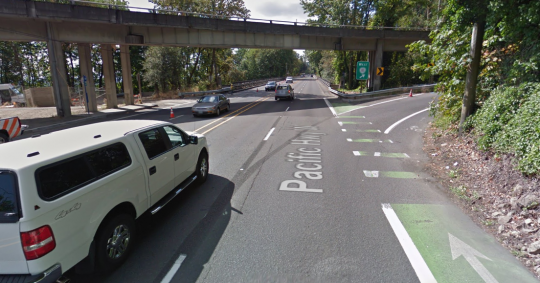
(Image: Google Street View)
Consensus seems to be building around a new concept that could finally create continuous bike lanes on state-run Barbur Boulevard.
And now, support for changes to a notoriously dangerous section of Barbur have a new ally: U.S. Congressman Earl Blumenauer.
“I look forward to seeing these much needed and long awaited safety improvements in the very near future.”
— Earl Blumenauer, U.S. Congressman
In a letter Monday (PDF) to the Oregon Department of Transportation, Portland Transportation Commissioner Steve Novick made the case for converting a southbound lane of Barbur to an exit-only lane in order to free up road space just to the south to add buffered bike lanes across two narrow bridges.
If ODOT agrees, Novick wrote, he was “hopeful” that restriping could happen in 2016.
Novick sent his letter to ODOT Region 1 Manager Rian Windsheimer and attached a letter from Blumenauer. Blumenauer’s letter was addressed to ODOT Director Matt Garrett and cc’d to Karmen Fore, Governor Kate Brown’s transportation policy chief.
“This report makes it clear,” Blumenauer writes, referring to a recent safety audit conducted by ODOT. “Barbur Blvd needs significant safety investments, and there are actions that can be taken in the next few months to address some of the critical improvements that will save lives and are long-awaited by the community and my constituents.”
It’s rare for a congressman to weigh in on a local transportation issue, but as someone who used to hold Novick’s job as city transportation commissioner, Blumenauer is no stranger to these waters.
Last month, the ODOT-commissioned safety audit found that almost half of southbound traffic on Barbur already turns right at Capitol Highway. Officially converting the rightmost lane to a right-turn-only lane “should have minimal impacts,” said Novick, whose personal car commute to City Hall happens to run along Capitol Highway and Barbur.
“This lane removal could be as short as 2,900 feet, just long enough for people walking and biking to cross the two bridges safely,” Novick said.
The problem with the two bridges is that Barbur’s bike lanes disappear, forcing bike and car traffic to merge into the same 45 mph lane. It’s the only relatively flat bike route between Southwest Portland and the rest of the city.
Novick also, for the first time, endorsed a change to make Barbur safer to drive on and its bike lane more comfortable: narrowing the general travel lanes from 11.5 and 12.5 feet to 11 feet in order to add a two-foot buffer between bike and auto traffic throughout.
Based on conversations with constituents, advocates, neighbors and City staff, the City of Portland strongly supports 11-foot wide travel lanes throughout the corridor as well as a two-foot buffer for bike lanes. Numerous studies have highlighted the ability of narrow travel lanes to reduce motor vehicle speeds, and thereby improve safety.
That 11 feet is wider than the national minimum standard of 10 feet for lanes on a higher-speed urban arterial. TriMet buses and most trucks are 10.5 feet wide, mirror to mirror.
Advertisement
And Blumenauer has Novick’s back 100 percent, saying in his letter that he supports the removal of one southbound lane and narrowing of existing lanes to make room for “protected bikeways.”
Unlike the Bicycle Transportation Alliance, Novick didn’t call for physically protected bike lanes and sidewalks to be installed right away. But he did say that they’re an important longer-term goal: “Two-foot buffers will have an immediate safety benefit, but roadways like Barbur need protected bicycle facilities and sidewalks to encourage their full use.”
In his letter, Novick also offers a useful analogy from ODOT’s own playbook.
I believe removing the southbound lane over the Newbury and Vermont bridges is in the same spirit as the recent change ODOT made on the last mile of I-84 in which two lanes were dedicated toward I-5 south as opposed to I-5 north. This change had safety improvements and was generally not noticed by road users because it reflected the natural flow of traffic.
As someone who regularly drives on this mile of 84, I can certainly attest to loving this restriping — it makes it much easier for people driving west to avoid last-minute lane changes when I-84 meets I-5, which I’m sure reduces crash rates.
If a similar common-sense restriping could also add continuous bike lanes to Barbur, it’s hard to see what’s standing in the way of Novick’s proposed 2016 timeline — especially now that Blumenauer is pushing in the same direction.
— Michael Andersen, (503) 333-7824 – michael@bikeportland.org


